|
 |
| 15/16/17 - 08 - 2008 WEST HIGHLAND TOUR |
THE WEST HIGHLAND TOUR DAY 1 Arriving at Achnacarry at 3pm, we found the Clan Chief Donald Cameron waiting outside the museum on our arrival, where we were warmly greeted. |
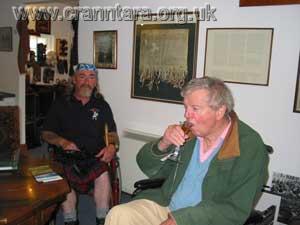 |
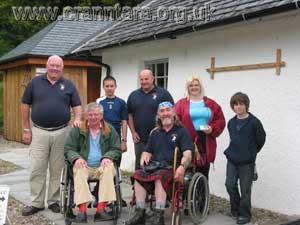 |
Locheil drinks a toast with Lachlan looking on |
Crann Tara members with Locheil |
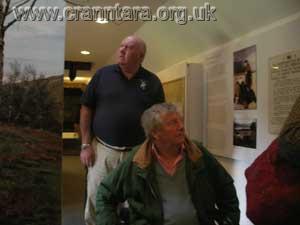 |
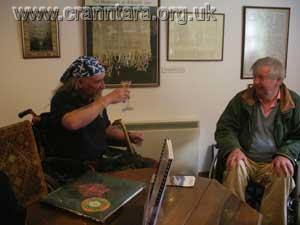 |
Brian with Locheil |
Lachlan toasts Locheil |
| THE WEST HIGHLAND TOUR DAY 2 Saturday 16th August 2008 9am Due to the same people being there as the previous day it was decided that another visit to Achnacarry wasn’t required, so instead we set out to discover High Bridge from the side nearest to the Commando Monument at Spean Bridge, instead of the usual route. This idea was also to give others time to appear should they have been held up or late. There is no real pathway down to the gorge from this side so crossing a field seemed the best option, following sheep trails to avoid the bog etc. As described in various books relating to Highbridge, the area around the bridge was densely over grown with trees, this still remains the case and a view of the bridge is very difficult. As you come within 50 yards of the bridge the land begins to drop steeply towards the gorge, footing can be dangerous particularly when it is wet underfoot. Because of the trees and the other over growth the bridge from this side is still vey hard to see even though you are just about upon it. Particular care needs to be taken on this side of the bridge as it seems less stable. There is a better view of the original Wades road from this side of the bridge though and a vision of where the redcoat soldiers under the command of Captain John Scott and Captain James Thomson came from. We must have actually been standing near the spot where a sergeant and another man from Sinclair’s Royal Scot Regiment were captured by the small Jacobite party at the time of the skirmish at Highbridge prior to the raising of the Standard at Glenfinnan. This was after the regiment started hearing the bagpipes in the vicinity of the bridge and then seeing highlanders jumping and leaping among the rocks on the other side, the red-coated soldiers halted before crossing the bridge. After discussion the sergeant and the other man, who is unknown, were ordered to approach the bridge to try and find out the possible strength of the Jacobite force, but before they got any distance at all their enemy sprang from behind trees and before anyone knew what was going on they were hurried across the bridge out of sight. At the same moment the piper skirled out another unearthly Piobroch and the highlanders began leaping among the bushes etc like wild cats making it appear that they were going to make a desperate rush. In anticipation that this was about to happen the soldiers of the Sinclair’s Royal Scots high tailed it back along the road that they had just travelled, all the way back to Fort Augustus leaving the two captives behind. After taking a few pics we made our way back the Commando Monument trying to find an alternative route, but one was just as bad as the other. Eventually arriving back at the monument, it was swarming with tourists and after speaking with a few of them and giving a wee brief history lesson we decided to move on. By now it was approximately 10.30am and with no one else appearing we altered the tour to suit ourselves missing out some of the places we had seen before. We moved directly down to the ruins of Fassiefern House, this was the site where Charles Edward Stewart stayed after the raising of the Standard at Glenfinnan on the route to meet Cope at the Corrieyairack. It is also the place where The Prince picked the wild rose, which became the symbol of the Jacobites. Due to the Highland Games being on at Glenfinnan, we decided to pass through and head for Borrodale House instead. Borrodale House is on the north side of Loch Nan Uamh where the Prince landed after sailing from Eriskay and here he stayed from the 4th to the 11th of August 1745 with Angus MacDonald as during the time of the 45 it was owned by the Clanrannald. It was from here that he wrote letters to various Clan Chiefs and friends summoning them to muster at Glenfinnan. The house that is there today stands in the place of the original, which was burnt down in 1746 by the Hanoverian army. Curious to find out more information I knocked on the door, the house today is leased for self catering accommodation, so there was a good chance of a tenant being in residence. Answering the door was a very pleasant man who when told what I was there for was more than helpful. He showed us a copy of the letter from Clunie with his intention to join the Prince’s army and a framed document which related to the history of the house. Before leaving he made us aware and directed us to the Prince’s cave, where it was believed he stayed while in hiding after Culloden. Following his direction we went in search of the cave, it did take a bit of finding, but we got there eventually. Leaving Borrodale House behind we headed a couple of miles west to The Prince’s cairn at Loch Nan Uamh, meaning ‘Loch of the Cave’, this is where the Prince and a few others eventually left for France leaving the failed Jacobite cause behind. The cairn which stands at the end of a path on the rugged shoreline was erected by the 1745 Association to mark the spot on October 4th 1956. After speaking with numerous tourists who were curious by what we were doing we headed for Kinloid Farm Arisaig where we camped for the night. Although the campsite is few miles inland it has spectacular views over the mountain ranges on the Isle of Skye. It was also one of the few campsites that I have been on that the owner didn’t mind you having a wee fire. As we had previously eaten in and around the tent, we decided to treat ourselves to a meal out at the Arisaig Hotel where the food was excellent. To walk it off we had a slow quiet walk round the marina at Arisaig then returned to the camp where we enjoyed the views and a wee drink around the fire. The piece and quiet was temporarily disturbed, but it was in a pleasant way for a change!!! It was the sound of the Jacobite Steam train which runs from Mallaig to Fort William. Funny as it may seem but the sound of the steam engine chuffing and puffing was quite therapeutic as it made its way along the track. As the campsite was in within throwing distance of the train we were greeted with sound of the engines whistle and the waving of all the passengers to the delight of the boys. After the excitement we settled down to our wee dram again and invited the folk from the two other tents to join us, a relaxing end to a day. |
 |
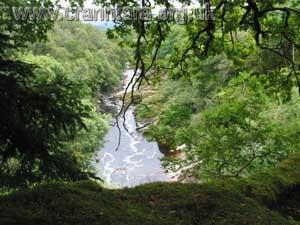 |
Highbridge through the trees |
A view of the gorge from the bridge |
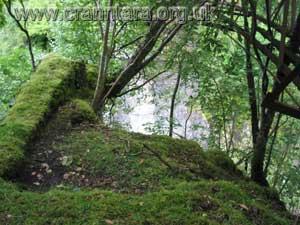 |
 |
The decaying bridge |
The remains of Wades Road to the bridge |
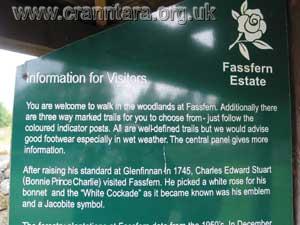 |
 |
Information board at Fassiefern |
What remains of Fassiefern House |
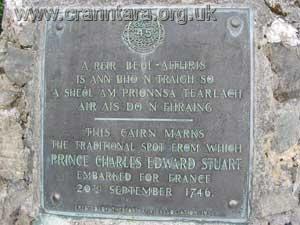 |
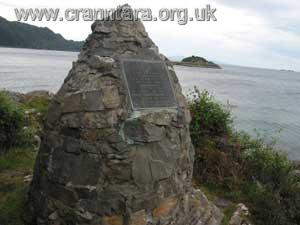 |
The Cairn at Loch Nan Uamh |
Over looking Loch Nan Uamh Bay |
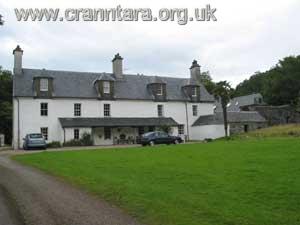 |
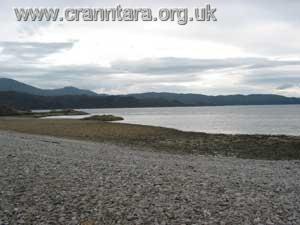 |
Borrodale House |
The Bay near Borrodale House where the Prince came ashore |
 |
 |
The hidden entrance to the Princes Cave |
Connor at the Cave entrance |
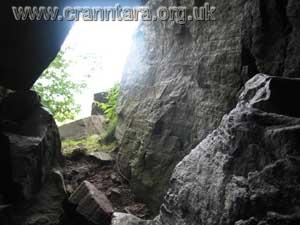 |
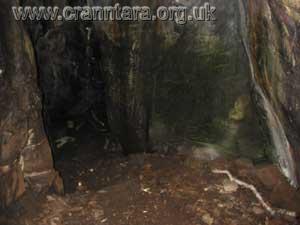 |
A view from within |
The cave opens up inside |
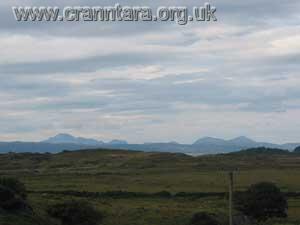 |
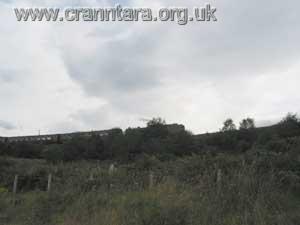 |
View of the Cullins from the camp |
The Jacobite Steam Train |
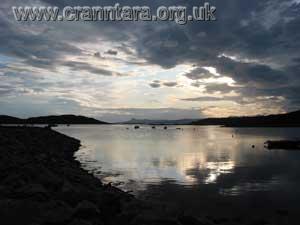 |
 |
Views from the Arisaig marina |
Enjoying a wee dram at the camp fire |
The West Highland Tour
Day 3 As this was our last day and we still had a few things to see, it was decided to make a half reasonable early start to the morning. With the weather forecast predicting rain we were surprised that the skies above were blue, which they had basically been through out. By Jim Singer |
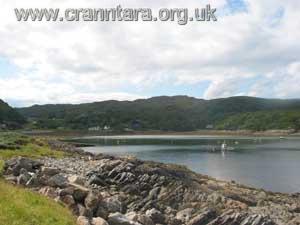 |
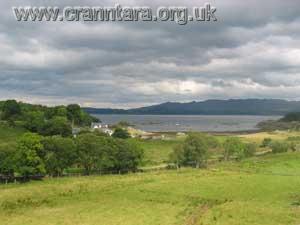 |
Glenuig Bay where the Prince came ashore from Borrodale |
Glenuig Bay lookig towards Arisaig |
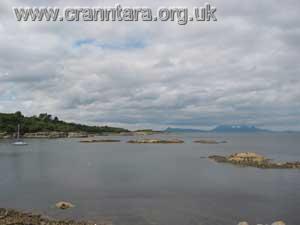 |
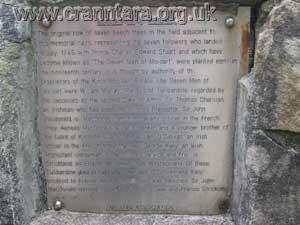 |
Glenuig Bay looking towards the Cullins |
The Seven Men of Moidart |
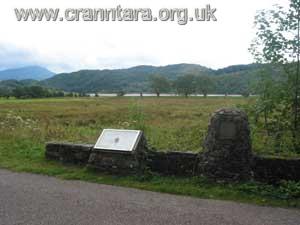 |
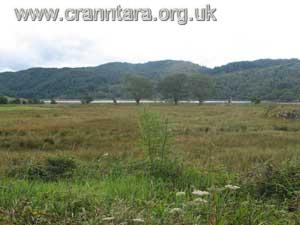 |
The Plaque |
The Seven Trees in the Meadow |
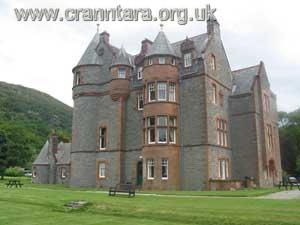 |
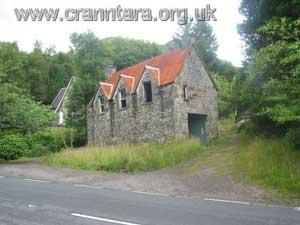 |
The Kinlochmoidart House |
Old House at Glenfinnan |
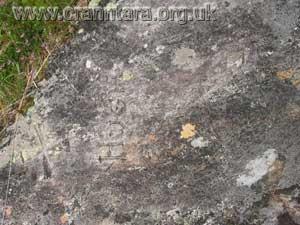 |
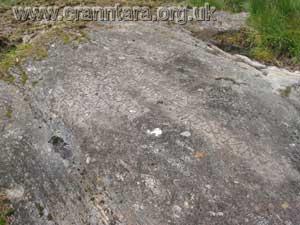 |
The spot where Hugo MacDonald allegedly stood |
The Stone Tablet uncovered by the heath fire |
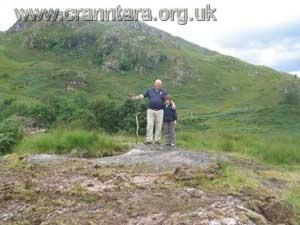 |
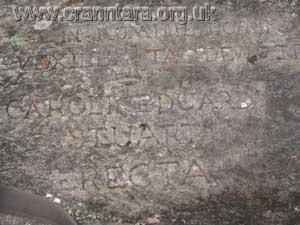 |
Brian and Connor at the spot where the Standard was allegedly raised |
Engraved words on Stone tablet |
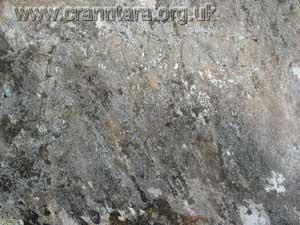 |
 |
The spot where the Marquis of Tullibardine allegedly stood |
A view down Glen Sheil with the Monument to the fore |
|